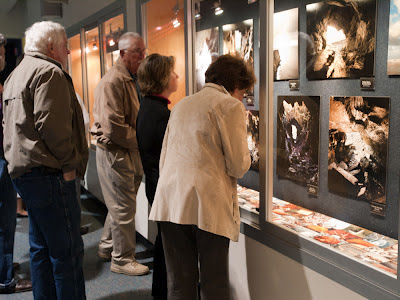This was always going to be an evening of exultation and intrepidation I had every confidence in Kitty Dough (who designed the invite), Larry Warner the exhibits curator and all of the staff and volunteers at the Aquarium; I just had to make sure I didn’t mess it up!

I had made a practice run of the presentation a few days earlier. This was taking place in the perfect location. I was to share the room with a 285,000-gallon shark tank ”Graveyard of the Atlantic” that’s 35-foot long and 14 feet tall. As well as the sharks, and numerous smaller fish which sometimes become dinner, the tank holds a 1/3 scale replica of the USS Monitor, which lies just off Cape Hatteras at a depth of 210 feet. The room is essentially lit by the dull blue glow coming through the 5.5 inch thick acrylic window of the tank. The projector screen seemed massive, like a small cinema, and combined with the powerful projector made my images look awesome. I spent a lot of time getting used to a wireless mouse because I was using Adobe bridge for the slideshow which enabled me to use big files and zoom right into the images.
 Meeting and greeting was at 6pm around the exhibition cabinets. This helped to guage the interest level and questions my audience might have; and calmed my nerves. There was a great spread of Anglo/American food available that had either been bought from the next State that likes to call itself a commonwealth, or homemade like the scones.
Meeting and greeting was at 6pm around the exhibition cabinets. This helped to guage the interest level and questions my audience might have; and calmed my nerves. There was a great spread of Anglo/American food available that had either been bought from the next State that likes to call itself a commonwealth, or homemade like the scones.

7pm was the presentation. Kitty introduced me to the audience numbering 50+. The talk was far more than my photographs, although there was a fascination in the way I construct my images from as many as 100 seperately taken frames. This exhibition, to me, had always been about introducing Manteo to it’s twin town through it’s surrounding coast, river and, originally shared, history. Using old maps, the North Devon Area of Outstanding Natural Beauty map and Richard Larn’s shipwreck map, I took my audience on a journey from Marsland Mouth on the border with Cornwall, along the Hartland coast, across Bideford Bay, up the Torridge into Bideford, around Saunton Sands to Baggy Point, along to Briery Cave at Watermouth, into Combe Martin and it’s caves which were mines; and finished off on the Exmoor coast at Wringapeak, near to the Somerset border.

It was supposed to be a half hour presentation and in practice it had been 45 minutes to I had vowed to cut it shorter. But, when I get excited I can’t stop; so it was more like 50 minutes, plus questions which were many. Nobody seemed to mind the length except perhaps my ever supportive wife Sadie who had been gesticulating ‘cut it’ and ‘wind it up’ but I hadn’t noticed! Sadie is also credited for all of these photographs.